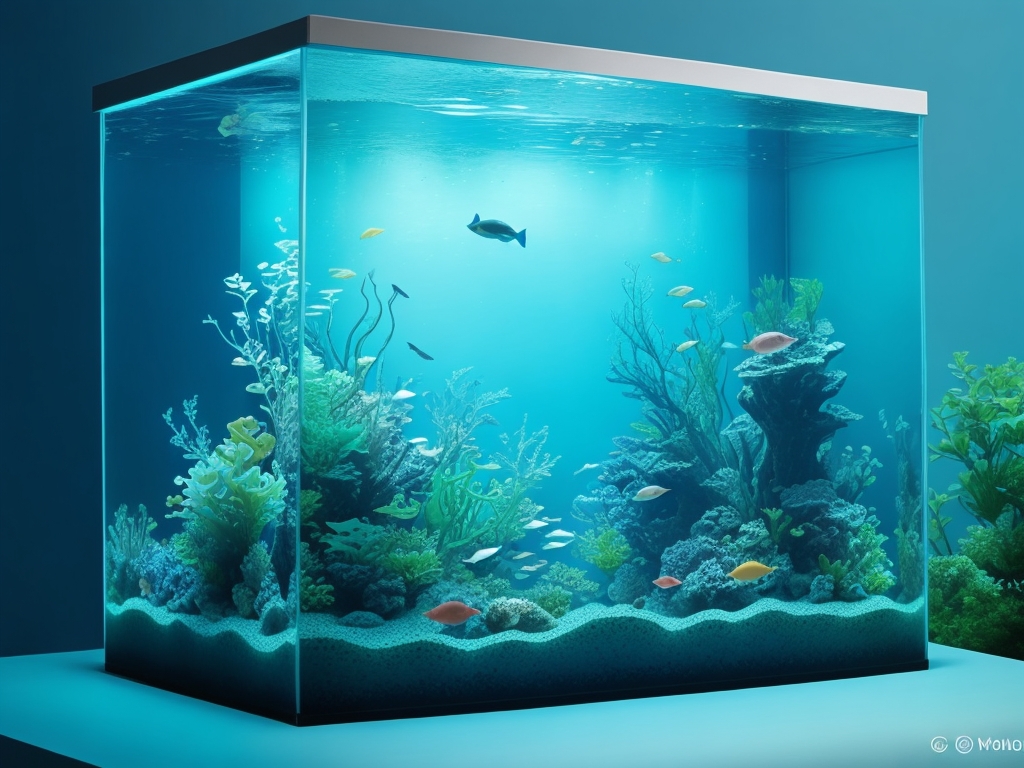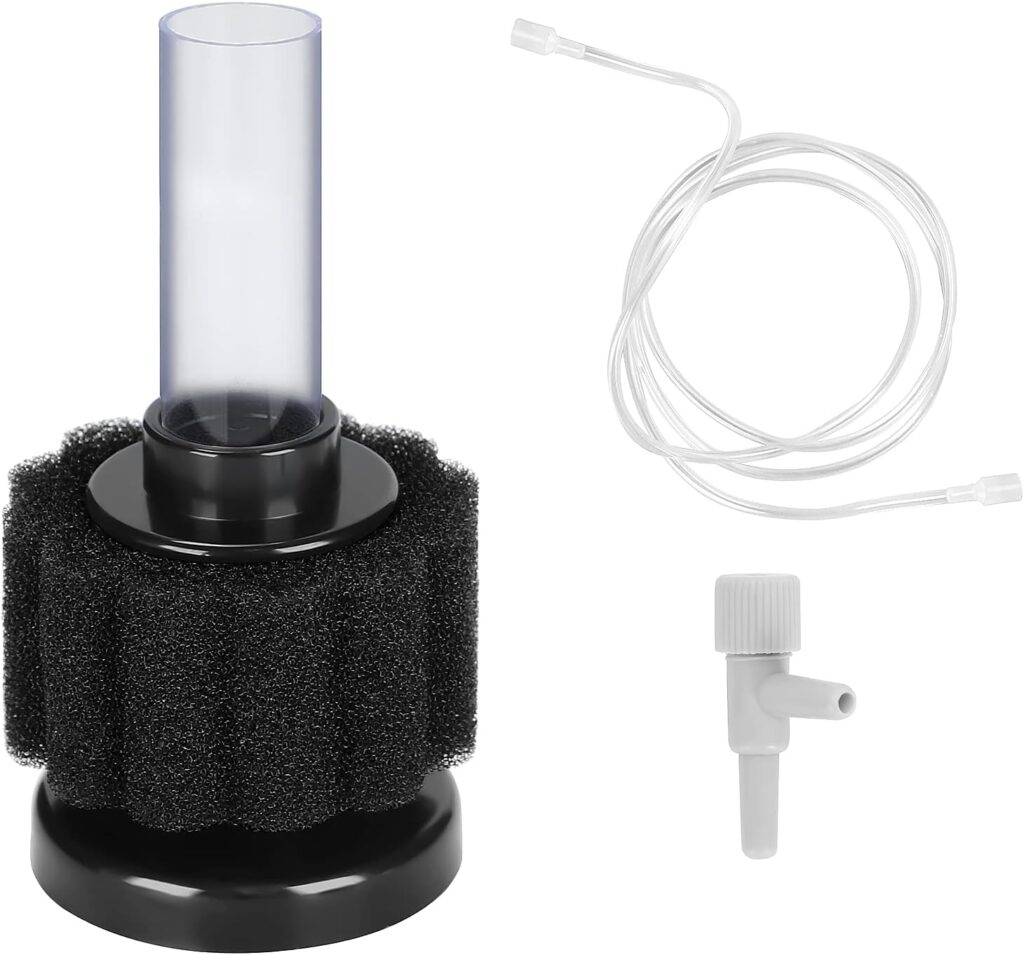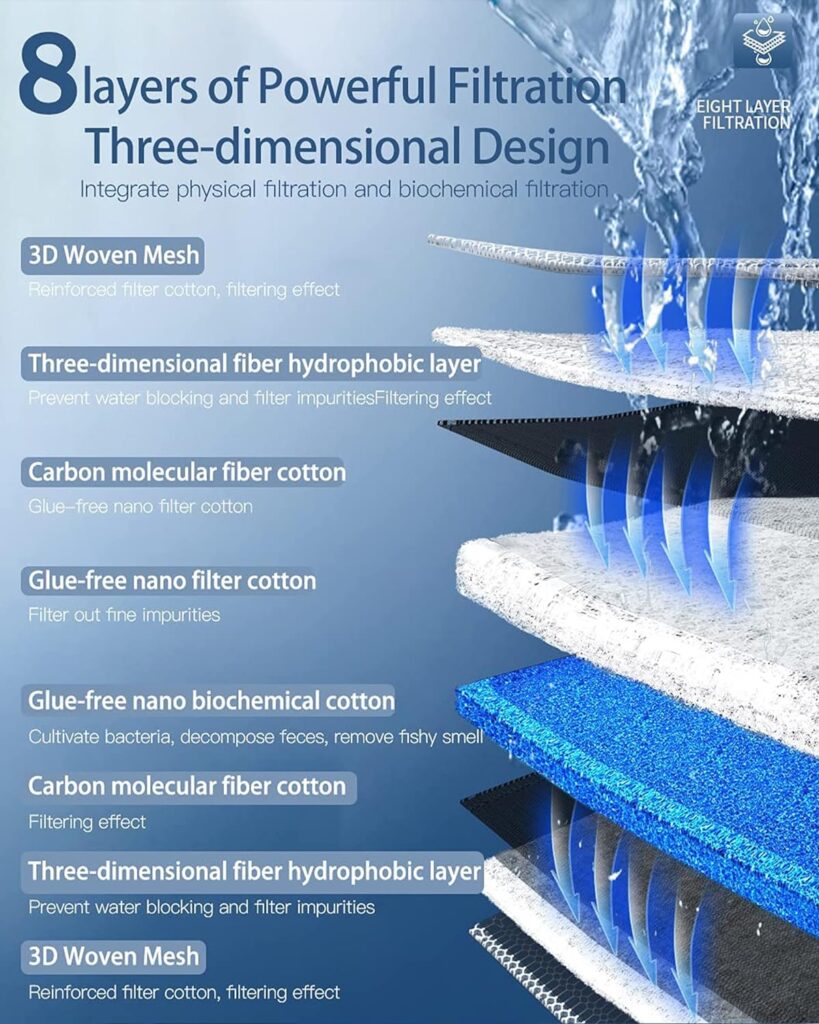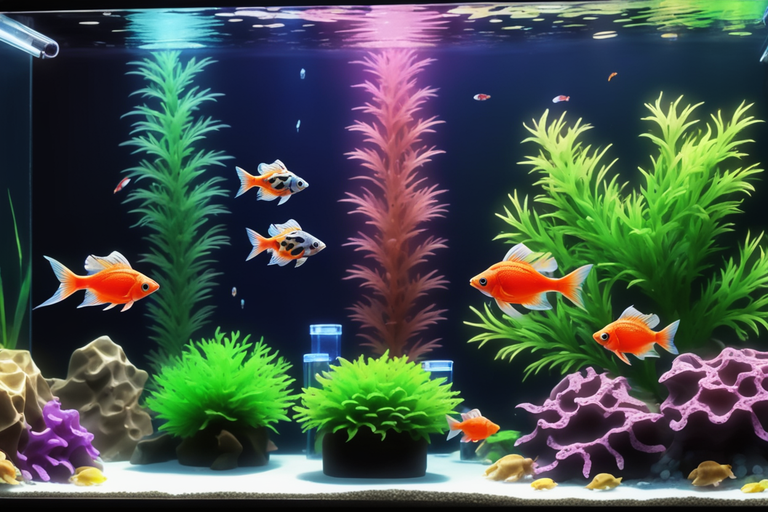Are you curious about how to keep your aquarium clean and clear? Wondering what types of filters are available and how they work?
Then look no further! In this article, you’ll discover all about mechanical filtration and the various filter media used to achieve it.
With this knowledge, you’ll be able to choose the right filter to keep your aquarium beautiful – so let’s dive right in!
Key Takeaways
- Mechanical filtration is essential for removing solid waste and maintaining water clarity in aquariums.
- Different types of mechanical filter media, ranging from very coarse to extra fine, are used to filter out particles of different sizes.
- Regular maintenance is required to prevent clogging and ensure the effectiveness of the mechanical filter.
- While not essential for saltwater tanks, mechanical filtration can still be beneficial in certain situations, such as after a water change or when the water becomes cloudy.
Understanding Mechanical Filtration in Aquariums: Essentials for a Healthy Aquatic Environment

You’re probably familiar with the concept of mechanical filtration in aquariums. Mechanical filtration is one of the three types of filters used in aquariums, along with biological and chemical filtration. It traps and strains solid waste particles, like fish poop and uneaten food, to keep the water clear and healthy. Without it, the tank would become cloudy and the water quality would suffer.
Different types of mechanical filter media are available, such as filter pads, filter floss, and sponges. Each is graded by the size of the pores that allow water to pass through, with coarser media having larger pores and finer media having smaller ones. Layering different types of mechanical filters can help create a customized filtration system. Extra fine filter media is the most effective, trapping particles as small as one micron. It can also remove parasites and bacteria that the naked eye can’t see.
When choosing a mechanical filter, consider the tank size, water flow rate, and maintenance needs. Filter pads are the most common and customizable type, but cartridge media may provide better filtering. Mechanical filtration isn’t essential for saltwater tanks, but can still be beneficial in certain situations.
Types of Aquariums: Saltwater vs. Freshwater

Frequently, aquarium owners must decide between setting up a saltwater or freshwater tank. Freshwater tanks tend to be more affordable and easier to maintain than saltwater tanks, but saltwater tanks can provide a larger variety of fish and colors. Both types of tanks require mechanical filtration to remove solid waste and maintain water clarity.
| Saltwater | Freshwater |
|---|---|
| Reef tank | Fish tank |
| Filter sock | Sponge filter |
| Live rock | Activated carbon |
| Protein skimmer | Gravel filter |
| Water changes | Water changes |
In saltwater aquariums, mechanical filtration is not essential but can still be beneficial for removing suspended waste after a water change or when the water becomes cloudy. It is achieved with filter socks, live rock, protein skimmers, and water changes. In freshwater tanks, mechanical filtration is achieved with sponge filters, gravel filters, activated carbon, and other media. Whichever tank you choose, regular maintenance is necessary to prevent clogging and ensure the effectiveness of the mechanical filter.
Exploring Different Types of Mechanical Filtration
@ Midjourney AI Image Prompt: /imagine prompt:A close up of multiple mechanical filter components in an aquarium, displaying the various shapes and sizes of the components. –v 5.2 –ar 16:9
Are you curious about different types of mechanical filtration for aquariums?
Let’s explore the role of mechanical filters and the various types of filter media available to you.
Learn what type of filter is best for your tank and how to maintain it for optimal performance.
Understanding the role of mechanical filter media
By understanding the different types of mechanical filter media available, you can customize your filtration system to best suit your aquarium needs.
Coarse filter media like sponge filters and filter floss are used to pre-filter out larger waste particles, while extra fine filter media can trap particles as small as one micron.
Canister filters, which are popular for reef tanks, combine mechanical, chemical, and biological filtration for optimal water clarity.
Saltwater aquariums typically don’t use mechanical filtration, but it can still be beneficial for removing suspended waste.
Ultimately, selecting the right filter media for your specific aquarium setup is key to successful mechanical filtration.
Different types of mechanical filtration systems
Do you want to know more about mechanical filtration?
Let’s explore the different types of mechanical filters available.
- Sponge filters
- Canister filters
- Power filters
- Fluidized bed filters
These filters can help keep your aquarium clean and healthy.
Sponge Filters
One of the most popular types of mechanical filtration is the sponge filter. It consists of filter material contained in inserts that fit inside the filter box. The filter material can be sponges, filter floss, or other media used as a pre-filter sponge to prevent filter clogs.

Sponge filters are excellent mechanical filters for long aquariums, as they can trap small particles and are easy to maintain. Different types of mechanical filtration can be layered to create a customized filtration system.
Canister Filters
While canister filters are a great choice for larger tanks, they’re more complex and require more maintenance than other types of mechanical filters. Canister filters use a combination of filter media in a pressurized filter system to achieve mechanical filtration. The filter media can range from coarse to fine mechanical, and may include filter rollers, sponges, and other media in the filter.
Canister filters are an effective way to achieve aquarium filtration, but the maintenance requirements may be too much for some aquarium enthusiasts.
Power Filters
Exploring different types of mechanical filtration systems, you can find power filters that utilize pressurized filter systems to achieve mechanical filtration. These filters include:
- Aquarium Filter Pads
- Pre Filters
- Fine Filters
- Felt Filters
- Ceramic Media

Power Filters are highly effective for mechanical filtration, as they can remove waste particles as small as one micron. Regular maintenance is required to prevent clogging and ensure the effectiveness of the filter.
Fluidized Bed Filters
Building on the discussion of power filters, fluidized bed filters are another type of mechanical filtration system. These filters use a submerged filter media to achieve effective mechanical filtration. The filter media, such as aquarium filter floss, traps debris from the water, like fish waste. Fluidized bed filters are usually used in combination with a chemical filter and biological filter media.
Fluidized bed filters have the advantage of replicating the natural environment of aquatic life. They help to keep the tank free of waste and contaminants. These filters are especially suitable for large aquariums and overstocked tanks.
However, fluidized bed filters require regular maintenance to keep the mechanical filter media from clogging. This maintenance ensures that the filter continues to function effectively.
Selecting the best mechanical filtration type for your aquarium
When selecting the best mechanical filtration type for your aquarium, you’ll need to consider factors like tank size, water flow rate, and maintenance. There are three main types of aquarium filters: mechanical, biological, and chemical filtration.
Mechanical filters trap and strain solid waste from the water column, while bio filters use bacteria to break down organic waste. Chemical filters use activated carbon to remove toxins and odors.
Depending on the type of aquarium filter and size of the fish tank, you may need to use different types of filter media like filter pads, sponges, or cartridge media. Coarse filter media are better for pre-filtering and trapping larger pieces of waste, while extra fine filter media can provide crystal clear water by trapping even the smallest particles.
Choosing the right mechanical filter for your freshwater aquarium will ensure your fish get clean, healthy water and your tank stays healthy.
Mechanical Filter Media: Purpose and Types
Mechanical filter media are an integral part of aquarium filtration. They help to remove solid waste and maintain water clarity. Learning about the different types of media and their applications can help you get the most out of your mechanical filter system.
Definition and function of filter media in aquariums
Are you curious about the different types of mechanical filter media used in aquariums and their purposes?
Do you want to know the differences between mechanical filtration media and biological filter media?
Let’s take a look at the different types of filter pads and floss, ceramic media, and more.
Filter Pads and Floss
Often, filter pads and floss are used to mechanically filter waste particles from aquariums. Filter pads can be coarse or fine, with larger pores for larger particles, and smaller pores for finer particles.
Floss made of tightly bunched polyester fibers traps small particles down to one micron. Both can filter out parasites and bacteria. They should be used in conjunction with biological and coarse mechanical filters to achieve the best results.
Activated carbon and aquarium sump filters can also help maintain aquarium water. Pond filters are available for larger aquariums.
Ceramic Media
You may have heard of ceramic media when it comes to mechanical filtration in aquariums. Ceramic media is a type of mechanical filter media that is made up of tiny particles, which trap small particles like dirt and waste. It’s often used in combination with other mechanical and biological media for best mechanical filtration. Tank owners like filter media like ceramic media because it can be used in both fresh and saltwater aquariums via mechanical and biological filtration.
| Media Type | Size | Use |
|---|---|---|
| Ceramic | Small | Traps small particles |
| Filter Pad | Large | Pre-filters |
| Filter Floss | Small | Traps small particles |
| Sponge | Medium | Medium filtration |
| Cartridge | Varies | Elaborate filters |
Mechanical Filtration Media vs. Biological Filter Media
Comparing mechanical filtration media to biological filter media can help you decide which one is best for your aquarium.
Mechanical filtration uses physical barriers and activated carbon to trap solid waste like fish poop and uneaten food.
Biological filter media, on the other hand, uses beneficial bacteria to break down waste.
Both types of filtration help maintain water quality.
However, mechanical filters are better for polishing tap water and keeping it clear.
Chemical filtration, such as an aquarium polishing filter pad, can be added for further clarity.
Regular maintenance and water changes are still necessary for both types of filtration.
Benefits and applications of various types of filter media
Understanding the various benefits and applications of mechanical filter media can help you create an effective and customized filtration system. Mechanical filtration is one of the main types of filtration in aquariums, used to remove solid waste, such as fish poop, sludge, and uneaten food. It’s often coupled with biological and chemical filtration, such as activated carbon, to create a complete filtration system.
Mechanical filter media can trap particles as small as one micron, which helps keep your aquarium or pond water crystal clear. Additionally, it helps maintain the beneficial bacteria in your aquarium by preventing clogging and ensuring oxygen can reach them. Cleaning the filter regularly is important to maintain its effectiveness and prevent the buildup of waste.
Different types of filter media are available, ranging from coarse to extra fine, depending on the size of the particles you want to filter out. Layering these can create a highly effective filtration system for your aquarium or pond.
The Role of Mechanical Filters in Conjunction with Biological Filtration
Using a mechanical filter in conjunction with a biological filter can improve the quality of aquarium water. Mechanical filtration works by trapping and straining solid waste, while biological filtration uses beneficial bacteria to break down ammonia. A combination of the two types of filtration can help keep the water in your aquarium clear and clean.
Here are some tips for using a mechanical filter in conjunction with biological filtration:
- Use chemical media, such as activated carbon, to enhance chemical filtration. This can be especially beneficial in saltwater tanks, as the carbon will remove compounds that can be toxic to fish.
- Consider floating a mechanical filter in your aquarium. This will ensure that all of the water is filtered, helping to maintain water quality.
- Be sure to clean the filter regularly. This will help to prevent a nitrate spike and maintain the efficiency of the biological and chemical filtration.
- If you’re running a mechanical filter in another aquarium, ensure that you don’t leave any waste in the tank that could be transferred to the new aquarium.
- Use the right type of filter media for the job. There’s a range of mechanical filter media available, from very coarse to extra fine. Choose the one that best suits your needs.
Key Components of a Comprehensive Filtration System
Once you have mastered the basics of mechanical filtration, it’s important to consider the various components that can be included in a comprehensive filtration system.
Filter cartridges, filter inserts, and sponges are the most common types of mechanical filtration media, but there are other options such as filter floss and cartridge media. Each type of filter media has its own advantages and drawbacks, so it’s important to research the options and decide which one best fits your needs.
Proper maintenance is essential to ensure the filter materials are effective and long-lasting. Water changes and monitoring water quality are important for maintaining the health of the aquarium. In addition, changing the filter media regularly will help keep the tank clean and reduce waste buildup.
Lastly, for saltwater tanks, protein skimming and live rock are essential components of an effective filtration system. With these components, you can enjoy crystal clear water and a healthy aquarium.
Specialty Filters: Reef Tanks and Pond Applications
For reef tanks and ponds, specialty filters are often necessary to provide optimal water filtration. These unique systems require different types of filtration that are tailored to the specific needs of the tank or pond. Here are some important considerations when choosing a specialty filter:
- Utilizing pond filters for larger or outdoor aquatic setups
- Customizing filtration for non-traditional aquariums or ponds
- Unique filtration needs of reef aquariums
- Adjusting filtration to accommodate different fish species
- Specialized filtration media for different tanks and ponds
Mechanical filtration is a key component in any filtration system, regardless of the type of tank or pond. However, reef tanks and ponds require special attention when it comes to mechanical filtration. For these setups, coarse and fine filter media may need to be layered to create a customized filtration system. Extra fine filter media can also be added to provide crystal clear water and ensure the removal of even the smallest waste particles.
With proper maintenance, specialty filters can provide the perfect balance of filtration needed for these unique aquatic environments.
Fine-Tuning Filtration: From Pre-Filters to Polishing
Fine-tuning your filtration system is key to achieving clear, healthy water in your aquarium. Pre-filters and polishing filters are two essential components of a mechanical filtration system. Pre-filters catch large particles, such as fish poop, uneaten food, and dead plant pieces, before they reach the finer filter media. Coarse filter media are often used as pre-filters to prevent clogging of finer filter media. Polishing filters are the finer filter media that are capable of trapping even the smallest particles, such as parasites and bacteria.
Regular maintenance is required to clean and replace pre-filters and polishing filters to prevent clogging and ensure they are working optimally. Layering different types of mechanical filters can create a filtration system that is tailored to your aquarium’s needs. With the right combination of pre-filters and polishing filters, you can achieve crystal clear water and maintain a healthy aquatic environment.
Regular assessment of mechanical filtration efficacy
To ensure your mechanical filtration system works properly, it’s important to regularly assess its efficacy. This involves monitoring the water clarity, checking for clogging, and making sure beneficial bacteria have enough oxygen.
Here are five key aspects to consider:
- Monitor water clarity: If the water begins to cloud up, this might indicate that the filter needs cleaning or that the filter media is too fine and blocking the flow of water.
- Check for clogging: If the filter media is clogged, water can’t pass through it, which reduces the efficiency of the filter and can lead to a nitrate spike.
- Ensure oxygen levels: Without enough oxygen, beneficial bacteria can’t function properly. Monitor oxygen levels to make sure the filter is operating correctly.
- Clean regularly: Regularly cleaning the filter media is essential to prevent buildup of waste, ensure water clarity, and keep the filter operating efficiently.
- Use the right filter media: The type of filter media used can make a big difference in the effectiveness of the filtration system. Coarser filter media are less likely to clog and easier to clean, while finer filter media can filter out smaller particles.

